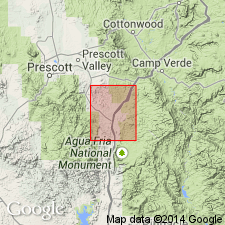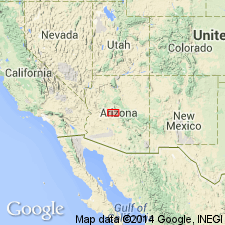
- Usage in publication:
-
- Bumblebee Granodiorite*
- Modifications:
-
- Named
- Dominant lithology:
-
- Granodiorite
- AAPG geologic province:
-
- Southwestern Basin-and-Range region
Summary:
zzzzzNamed for exposures in lower part of Bumblebee Creek, its type locality, T11N, R2E, Yavapai Co, AZ in the Southwestern Basin-and-Range region. Another outcrop occurs along lower part of Agua Fria River to east in T11N, R3E. Is a granodiorite characterized by abundant saussuritized plagioclase associated with larger hornblende crystals and smaller quartz crystals and chloritized biotite. K-feldspar is interstitial to quartz and plagioclase. Has a mafic border facies. Of Precambrian age, younger than an unnamed quartz diorite porphyry and older than Badger Spring Granodiorite (new). Gnu
Source: GNU records (USGS DDS-6; Denver GNULEX).

- Usage in publication:
-
- Bumblebee Granodiorite*
- Modifications:
-
- Age modified
- Overview
- AAPG geologic province:
-
- Southwestern Basin-and-Range region
Summary:
Assigned to suite three (of 4) in the Prescott area (Yavapai County, Arizona, Southwestern Basin-and-Range region). Suite three, consisting of pre- to late-tectonic, equigranular to porphyritic, medium- to coarse-grained biotite-hornblende granodiorite plutons, includes the 1,720 Ma quartz diorite at Bland, Bumblebee Granodiorite, and Badger Spring Granodiorite. The plutons are metaluminous, have low magnetite concentrations, low rubidium, zirconium, lanthanum, and cerium, and very low strontium, and are restricted to the southeastern part of the area. Bumblebee intruded by Badger Spring Granodiorite. Age is refined from Precambrian to Early Proterozoic. Report includes geochemical analyses.
Source: Modified from GNU records (USGS DDS-6; Denver GNULEX).
For more information, please contact Nancy Stamm, Geologic Names Committee Secretary.
Asterisk (*) indicates published by U.S. Geological Survey authors.
"No current usage" (†) implies that a name has been abandoned or has fallen into disuse. Former usage and, if known, replacement name given in parentheses ( ).
Slash (/) indicates name conflicts with nomenclatural guidelines (CSN, 1933; ACSN, 1961, 1970; NACSN, 1983, 2005, 2021). May be explained within brackets ([ ]).

